Economic Assignment: Exchange Rate and Currency Valuation
VerifiedAdded on 2020/04/07
|15
|2918
|84
Report
AI Summary
This economic assignment analyzes the Australian dollar's exchange rate and currency valuation, drawing on an article from the Sydney Morning Herald. It explores factors influencing the AUD, including commodity prices, interest rates, and RBA policies. The assignment examines exchange rate determination, fluctuations, and the impact of overvaluation. It also discusses the fixed exchange rate system, its benefits, and drawbacks. The report uses figures to illustrate exchange rate movements, trade-weighted indices, and commodity price trends. The analysis covers the period from 2014 to 2016, highlighting the relationship between exchange rates, commodity prices, and the overall economic conditions of Australia. The report also includes an examination of how a fixed exchange rate system works and the implications of maintaining it.
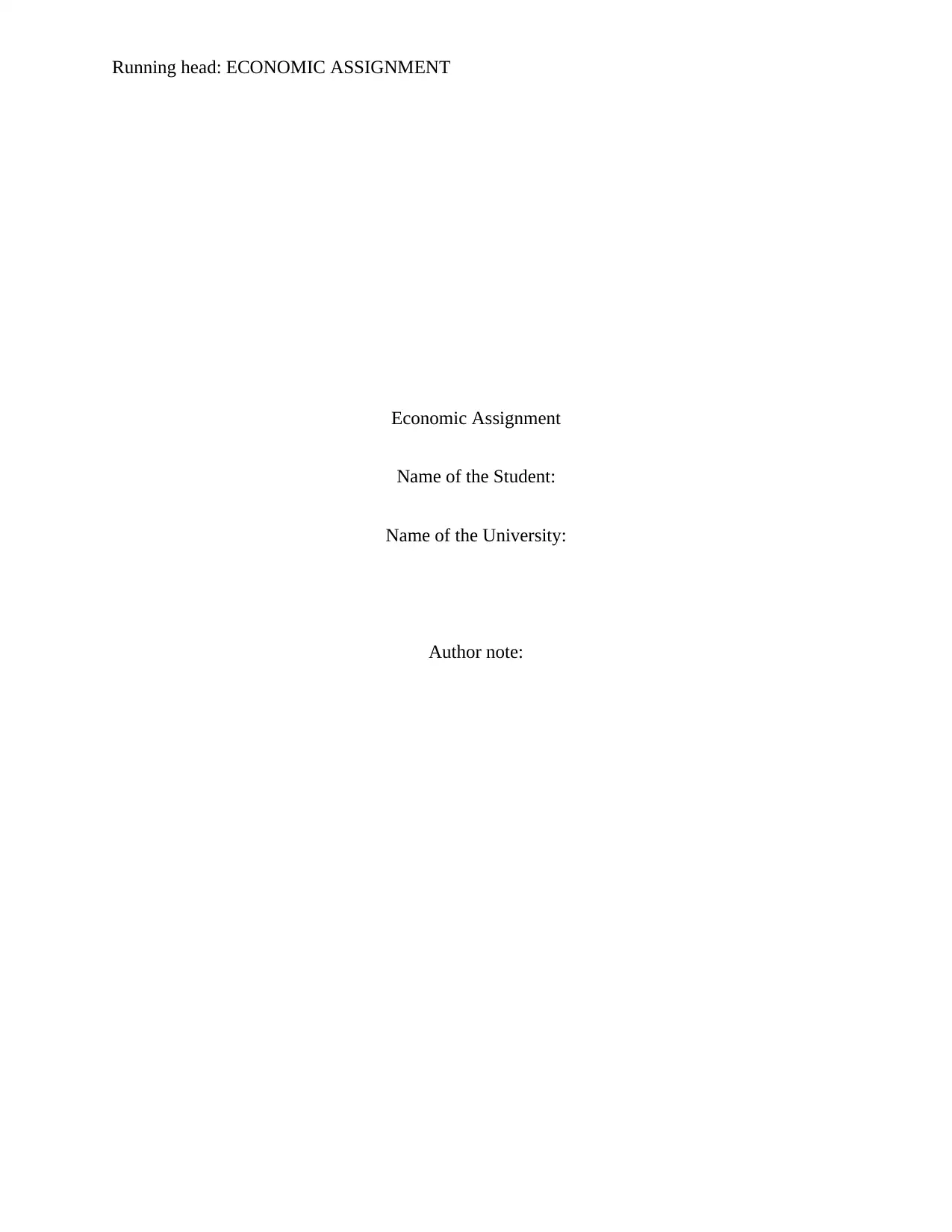
Running head: ECONOMIC ASSIGNMENT
Economic Assignment
Name of the Student:
Name of the University:
Author note:
Economic Assignment
Name of the Student:
Name of the University:
Author note:
Paraphrase This Document
Need a fresh take? Get an instant paraphrase of this document with our AI Paraphraser
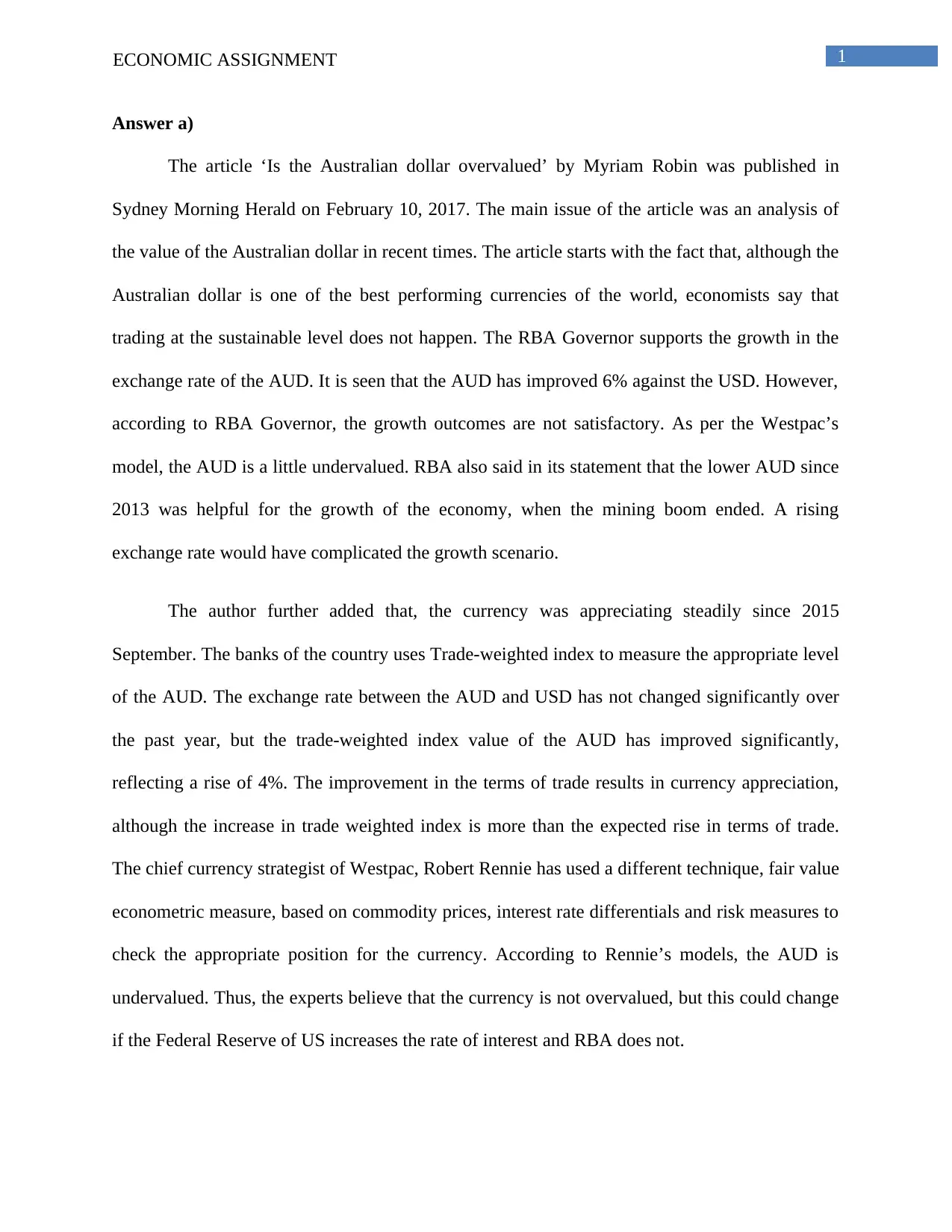
1ECONOMIC ASSIGNMENT
Answer a)
The article ‘Is the Australian dollar overvalued’ by Myriam Robin was published in
Sydney Morning Herald on February 10, 2017. The main issue of the article was an analysis of
the value of the Australian dollar in recent times. The article starts with the fact that, although the
Australian dollar is one of the best performing currencies of the world, economists say that
trading at the sustainable level does not happen. The RBA Governor supports the growth in the
exchange rate of the AUD. It is seen that the AUD has improved 6% against the USD. However,
according to RBA Governor, the growth outcomes are not satisfactory. As per the Westpac’s
model, the AUD is a little undervalued. RBA also said in its statement that the lower AUD since
2013 was helpful for the growth of the economy, when the mining boom ended. A rising
exchange rate would have complicated the growth scenario.
The author further added that, the currency was appreciating steadily since 2015
September. The banks of the country uses Trade-weighted index to measure the appropriate level
of the AUD. The exchange rate between the AUD and USD has not changed significantly over
the past year, but the trade-weighted index value of the AUD has improved significantly,
reflecting a rise of 4%. The improvement in the terms of trade results in currency appreciation,
although the increase in trade weighted index is more than the expected rise in terms of trade.
The chief currency strategist of Westpac, Robert Rennie has used a different technique, fair value
econometric measure, based on commodity prices, interest rate differentials and risk measures to
check the appropriate position for the currency. According to Rennie’s models, the AUD is
undervalued. Thus, the experts believe that the currency is not overvalued, but this could change
if the Federal Reserve of US increases the rate of interest and RBA does not.
Answer a)
The article ‘Is the Australian dollar overvalued’ by Myriam Robin was published in
Sydney Morning Herald on February 10, 2017. The main issue of the article was an analysis of
the value of the Australian dollar in recent times. The article starts with the fact that, although the
Australian dollar is one of the best performing currencies of the world, economists say that
trading at the sustainable level does not happen. The RBA Governor supports the growth in the
exchange rate of the AUD. It is seen that the AUD has improved 6% against the USD. However,
according to RBA Governor, the growth outcomes are not satisfactory. As per the Westpac’s
model, the AUD is a little undervalued. RBA also said in its statement that the lower AUD since
2013 was helpful for the growth of the economy, when the mining boom ended. A rising
exchange rate would have complicated the growth scenario.
The author further added that, the currency was appreciating steadily since 2015
September. The banks of the country uses Trade-weighted index to measure the appropriate level
of the AUD. The exchange rate between the AUD and USD has not changed significantly over
the past year, but the trade-weighted index value of the AUD has improved significantly,
reflecting a rise of 4%. The improvement in the terms of trade results in currency appreciation,
although the increase in trade weighted index is more than the expected rise in terms of trade.
The chief currency strategist of Westpac, Robert Rennie has used a different technique, fair value
econometric measure, based on commodity prices, interest rate differentials and risk measures to
check the appropriate position for the currency. According to Rennie’s models, the AUD is
undervalued. Thus, the experts believe that the currency is not overvalued, but this could change
if the Federal Reserve of US increases the rate of interest and RBA does not.
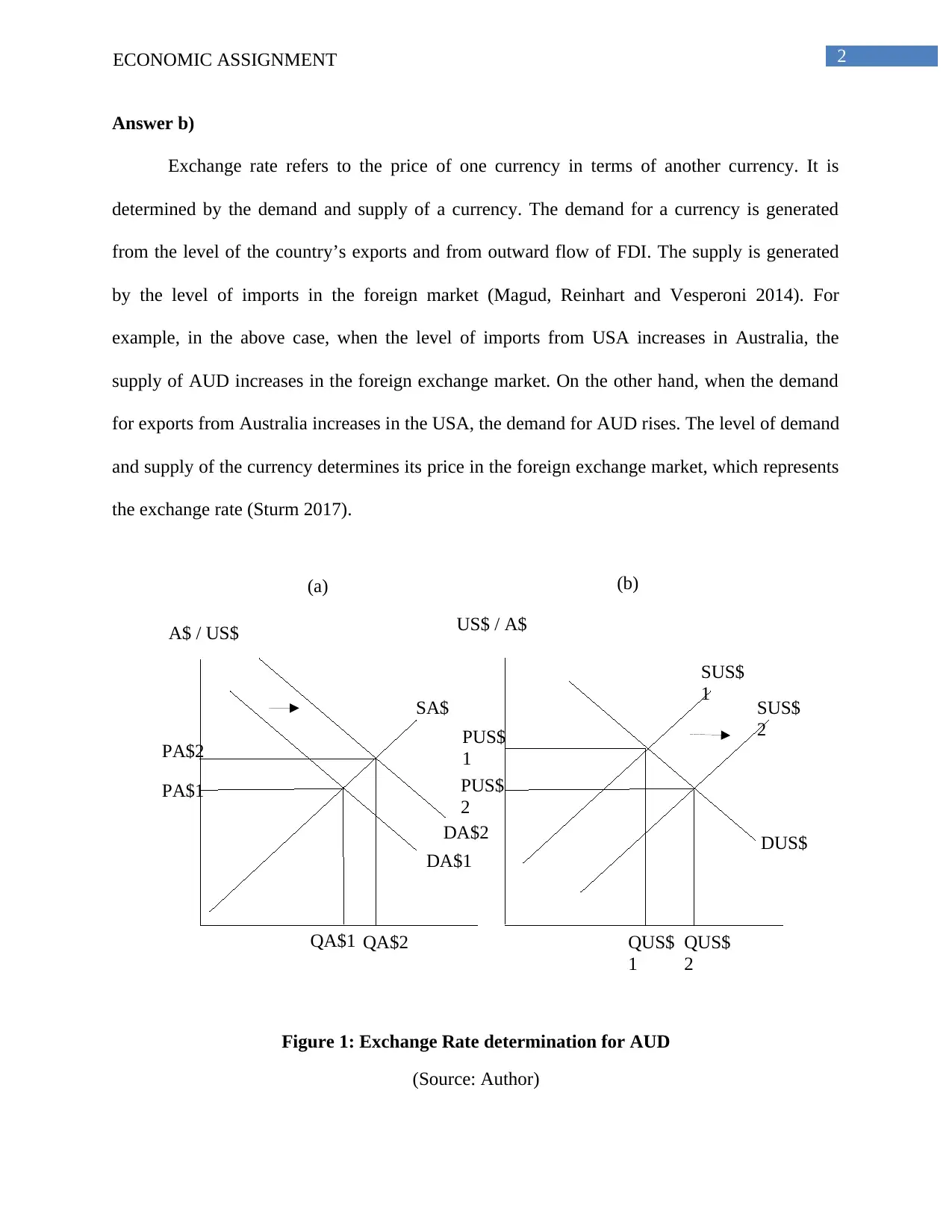
SA$
SUS$
1 SUS$
2
DUS$
DA$1
DA$2
PA$1
PA$2 PUS$
1
A$ / US$
QUS$
1
QUS$
2
QA$1 QA$2
PUS$
2
US$ / A$
(a) (b)
2ECONOMIC ASSIGNMENT
Answer b)
Exchange rate refers to the price of one currency in terms of another currency. It is
determined by the demand and supply of a currency. The demand for a currency is generated
from the level of the country’s exports and from outward flow of FDI. The supply is generated
by the level of imports in the foreign market (Magud, Reinhart and Vesperoni 2014). For
example, in the above case, when the level of imports from USA increases in Australia, the
supply of AUD increases in the foreign exchange market. On the other hand, when the demand
for exports from Australia increases in the USA, the demand for AUD rises. The level of demand
and supply of the currency determines its price in the foreign exchange market, which represents
the exchange rate (Sturm 2017).
Figure 1: Exchange Rate determination for AUD
(Source: Author)
SUS$
1 SUS$
2
DUS$
DA$1
DA$2
PA$1
PA$2 PUS$
1
A$ / US$
QUS$
1
QUS$
2
QA$1 QA$2
PUS$
2
US$ / A$
(a) (b)
2ECONOMIC ASSIGNMENT
Answer b)
Exchange rate refers to the price of one currency in terms of another currency. It is
determined by the demand and supply of a currency. The demand for a currency is generated
from the level of the country’s exports and from outward flow of FDI. The supply is generated
by the level of imports in the foreign market (Magud, Reinhart and Vesperoni 2014). For
example, in the above case, when the level of imports from USA increases in Australia, the
supply of AUD increases in the foreign exchange market. On the other hand, when the demand
for exports from Australia increases in the USA, the demand for AUD rises. The level of demand
and supply of the currency determines its price in the foreign exchange market, which represents
the exchange rate (Sturm 2017).
Figure 1: Exchange Rate determination for AUD
(Source: Author)
⊘ This is a preview!⊘
Do you want full access?
Subscribe today to unlock all pages.

Trusted by 1+ million students worldwide
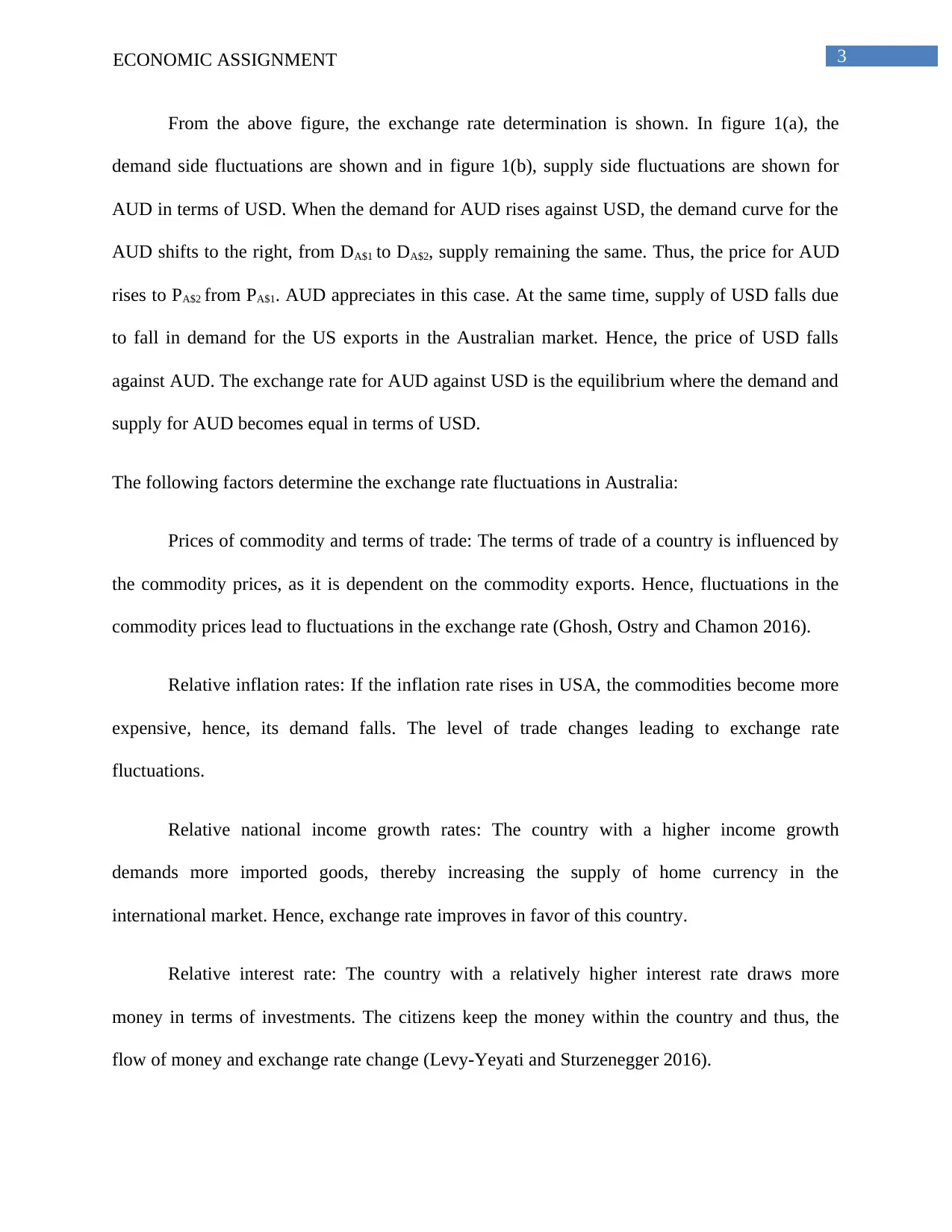
3ECONOMIC ASSIGNMENT
From the above figure, the exchange rate determination is shown. In figure 1(a), the
demand side fluctuations are shown and in figure 1(b), supply side fluctuations are shown for
AUD in terms of USD. When the demand for AUD rises against USD, the demand curve for the
AUD shifts to the right, from DA$1 to DA$2, supply remaining the same. Thus, the price for AUD
rises to PA$2 from PA$1. AUD appreciates in this case. At the same time, supply of USD falls due
to fall in demand for the US exports in the Australian market. Hence, the price of USD falls
against AUD. The exchange rate for AUD against USD is the equilibrium where the demand and
supply for AUD becomes equal in terms of USD.
The following factors determine the exchange rate fluctuations in Australia:
Prices of commodity and terms of trade: The terms of trade of a country is influenced by
the commodity prices, as it is dependent on the commodity exports. Hence, fluctuations in the
commodity prices lead to fluctuations in the exchange rate (Ghosh, Ostry and Chamon 2016).
Relative inflation rates: If the inflation rate rises in USA, the commodities become more
expensive, hence, its demand falls. The level of trade changes leading to exchange rate
fluctuations.
Relative national income growth rates: The country with a higher income growth
demands more imported goods, thereby increasing the supply of home currency in the
international market. Hence, exchange rate improves in favor of this country.
Relative interest rate: The country with a relatively higher interest rate draws more
money in terms of investments. The citizens keep the money within the country and thus, the
flow of money and exchange rate change (Levy-Yeyati and Sturzenegger 2016).
From the above figure, the exchange rate determination is shown. In figure 1(a), the
demand side fluctuations are shown and in figure 1(b), supply side fluctuations are shown for
AUD in terms of USD. When the demand for AUD rises against USD, the demand curve for the
AUD shifts to the right, from DA$1 to DA$2, supply remaining the same. Thus, the price for AUD
rises to PA$2 from PA$1. AUD appreciates in this case. At the same time, supply of USD falls due
to fall in demand for the US exports in the Australian market. Hence, the price of USD falls
against AUD. The exchange rate for AUD against USD is the equilibrium where the demand and
supply for AUD becomes equal in terms of USD.
The following factors determine the exchange rate fluctuations in Australia:
Prices of commodity and terms of trade: The terms of trade of a country is influenced by
the commodity prices, as it is dependent on the commodity exports. Hence, fluctuations in the
commodity prices lead to fluctuations in the exchange rate (Ghosh, Ostry and Chamon 2016).
Relative inflation rates: If the inflation rate rises in USA, the commodities become more
expensive, hence, its demand falls. The level of trade changes leading to exchange rate
fluctuations.
Relative national income growth rates: The country with a higher income growth
demands more imported goods, thereby increasing the supply of home currency in the
international market. Hence, exchange rate improves in favor of this country.
Relative interest rate: The country with a relatively higher interest rate draws more
money in terms of investments. The citizens keep the money within the country and thus, the
flow of money and exchange rate change (Levy-Yeyati and Sturzenegger 2016).
Paraphrase This Document
Need a fresh take? Get an instant paraphrase of this document with our AI Paraphraser
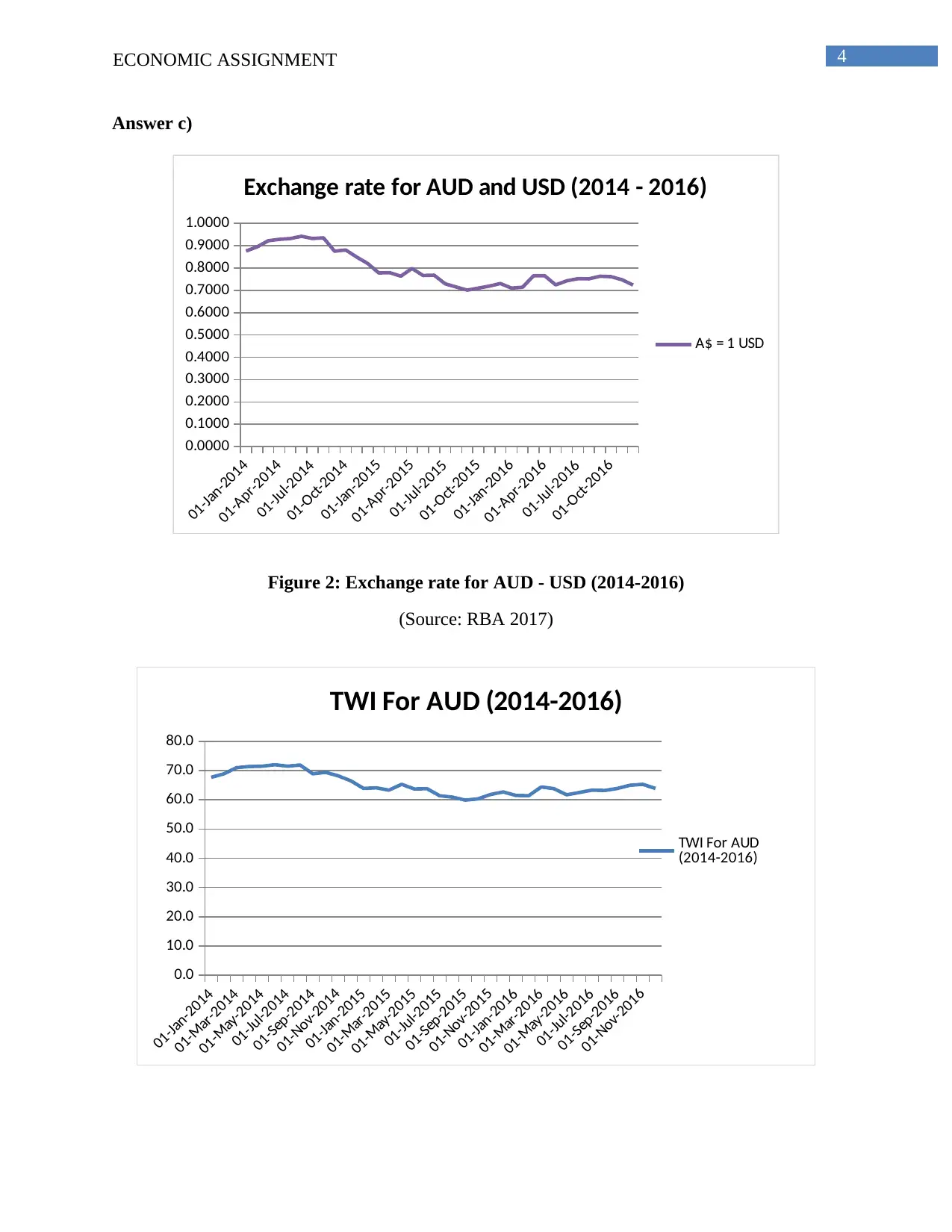
4ECONOMIC ASSIGNMENT
Answer c)
01-Jan-2014
01-Apr-2014
01-Jul-2014
01-Oct-2014
01-Jan-2015
01-Apr-2015
01-Jul-2015
01-Oct-2015
01-Jan-2016
01-Apr-2016
01-Jul-2016
01-Oct-2016
0.0000
0.1000
0.2000
0.3000
0.4000
0.5000
0.6000
0.7000
0.8000
0.9000
1.0000
Exchange rate for AUD and USD (2014 - 2016)
A$ = 1 USD
Figure 2: Exchange rate for AUD - USD (2014-2016)
(Source: RBA 2017)
01-Jan-2014
01-Mar-2014
01-May-2014
01-Jul-2014
01-Sep-2014
01-Nov-2014
01-Jan-2015
01-Mar-2015
01-May-2015
01-Jul-2015
01-Sep-2015
01-Nov-2015
01-Jan-2016
01-Mar-2016
01-May-2016
01-Jul-2016
01-Sep-2016
01-Nov-2016
0.0
10.0
20.0
30.0
40.0
50.0
60.0
70.0
80.0
TWI For AUD (2014-2016)
TWI For AUD
(2014-2016)
Answer c)
01-Jan-2014
01-Apr-2014
01-Jul-2014
01-Oct-2014
01-Jan-2015
01-Apr-2015
01-Jul-2015
01-Oct-2015
01-Jan-2016
01-Apr-2016
01-Jul-2016
01-Oct-2016
0.0000
0.1000
0.2000
0.3000
0.4000
0.5000
0.6000
0.7000
0.8000
0.9000
1.0000
Exchange rate for AUD and USD (2014 - 2016)
A$ = 1 USD
Figure 2: Exchange rate for AUD - USD (2014-2016)
(Source: RBA 2017)
01-Jan-2014
01-Mar-2014
01-May-2014
01-Jul-2014
01-Sep-2014
01-Nov-2014
01-Jan-2015
01-Mar-2015
01-May-2015
01-Jul-2015
01-Sep-2015
01-Nov-2015
01-Jan-2016
01-Mar-2016
01-May-2016
01-Jul-2016
01-Sep-2016
01-Nov-2016
0.0
10.0
20.0
30.0
40.0
50.0
60.0
70.0
80.0
TWI For AUD (2014-2016)
TWI For AUD
(2014-2016)

5ECONOMIC ASSIGNMENT
Figure 3: Trade Weighted Index for AUD (2014-2016)
(Source: RBA 2017)
The above two figures show the monthly exchange rate for AUD against USD and the
TWI for the AUD for the last three years, from 2014 to 2016. It is seen that, the exchange rate
has witnessed some fluctuations in the three years. In 2014, the average rate of exchange
between Australia and USA was 0.9, while it declined to 0.7 in 2015. It further improved in 2016
to 0.75 in an average. On the other hand, there have been very less fluctuations in the Trade
Weighted Index for AUD. The nominal value of TWI is quite higher than that of the exchange
rate. However, the trend or pattern of movement for the both the variables are quite similar in
Australia (RBA 2017).
This indicates that the exchange rate between the two countries has fallen. The impact is
favorable for Australia. The currency has depreciated in the past three years, hence, exports
became cheaper and imports became costlier. The Australian market became more competitive
for the US customers, as exports increased and imports decreased (Charles and Marie 2016).
Figure 3: Trade Weighted Index for AUD (2014-2016)
(Source: RBA 2017)
The above two figures show the monthly exchange rate for AUD against USD and the
TWI for the AUD for the last three years, from 2014 to 2016. It is seen that, the exchange rate
has witnessed some fluctuations in the three years. In 2014, the average rate of exchange
between Australia and USA was 0.9, while it declined to 0.7 in 2015. It further improved in 2016
to 0.75 in an average. On the other hand, there have been very less fluctuations in the Trade
Weighted Index for AUD. The nominal value of TWI is quite higher than that of the exchange
rate. However, the trend or pattern of movement for the both the variables are quite similar in
Australia (RBA 2017).
This indicates that the exchange rate between the two countries has fallen. The impact is
favorable for Australia. The currency has depreciated in the past three years, hence, exports
became cheaper and imports became costlier. The Australian market became more competitive
for the US customers, as exports increased and imports decreased (Charles and Marie 2016).
⊘ This is a preview!⊘
Do you want full access?
Subscribe today to unlock all pages.

Trusted by 1+ million students worldwide

6ECONOMIC ASSIGNMENT
Jan-14
Mar-14
May-14
Jul-14
Sep-14
Nov-14
Jan-15
Mar-15
May-15
Jul-15
Sep-15
Nov-15
Jan-16
Mar-16
May-16
Jul-16
Sep-16
Nov-16
0.0
20.0
40.0
60.0
80.0
100.0
120.0
140.0
Commodity Prices Indices (Monthly, 2014-
2016
Energy
Metals
Agriculture
Figure 4: Commodity prices movement (2014-2016)
(Source: RBA 2017)
Figure 5: Brent crude oil price movement (2014-2016)
(Source: RBA 2017)
Jan-14
Mar-14
May-14
Jul-14
Sep-14
Nov-14
Jan-15
Mar-15
May-15
Jul-15
Sep-15
Nov-15
Jan-16
Mar-16
May-16
Jul-16
Sep-16
Nov-16
0.0
20.0
40.0
60.0
80.0
100.0
120.0
140.0
Commodity Prices Indices (Monthly, 2014-
2016
Energy
Metals
Agriculture
Figure 4: Commodity prices movement (2014-2016)
(Source: RBA 2017)
Figure 5: Brent crude oil price movement (2014-2016)
(Source: RBA 2017)
Paraphrase This Document
Need a fresh take? Get an instant paraphrase of this document with our AI Paraphraser

7ECONOMIC ASSIGNMENT
Figure 6: Gold price in international market
(Source: RBA 2017)
Since Australia is a resource based economy, its economy is heavily dependent on the
export sector. Hence, the global economic conditions influence the trade conditions of Australia.
From the above figures it can be seen, that the Energy, Metals, and Agriculture sector, Brent
Crude Oil Price and Gold (industry benchmark) price movements are considered to get an idea
about the commodity price movements in the last three years. The above figures show heavy
fluctuations in the prices. The prices were high in 2014 for almost all the commodities and
sectors, which gradually declined in 2015 and 2016, except for gold, whose price increased in
2016 significantly. The trends in exchange rate and TWI for Australia also followed the patterns
of the commodity price movement for the three years from 2014 to 2016.
The global financial condition is a major contributory factor in the movement of AUD.
The fall in the exchange rate indicates the declining growth of the major sector of the country,
Figure 6: Gold price in international market
(Source: RBA 2017)
Since Australia is a resource based economy, its economy is heavily dependent on the
export sector. Hence, the global economic conditions influence the trade conditions of Australia.
From the above figures it can be seen, that the Energy, Metals, and Agriculture sector, Brent
Crude Oil Price and Gold (industry benchmark) price movements are considered to get an idea
about the commodity price movements in the last three years. The above figures show heavy
fluctuations in the prices. The prices were high in 2014 for almost all the commodities and
sectors, which gradually declined in 2015 and 2016, except for gold, whose price increased in
2016 significantly. The trends in exchange rate and TWI for Australia also followed the patterns
of the commodity price movement for the three years from 2014 to 2016.
The global financial condition is a major contributory factor in the movement of AUD.
The fall in the exchange rate indicates the declining growth of the major sector of the country,

8ECONOMIC ASSIGNMENT
i.e. resources and mining. However, the trade weighted index value was quite good, as
mentioned by the RBA Governor (Sturm 2017).
Answer d)
Overvaluation of currency occurs under fixed exchange rate. A currency is said to be
overvalued if the private demand for the currency is less than the private supply at the existing
exchange rate. Overvalued currency leads to overvalued rate of exchange. This implies that the
country’s value of currency is too high for the state of the economy. This results in costlier
exports and cheaper imports (Grossmann, Love and Orlov 2014). This can also be understood
with the help of Purchasing Power Parity (PPP). An overvalued currency makes the goods of that
country relatively costlier. Hence, if a producer exports alcohol to the United States during
overvaluation of AUD, then he would earn less than what he could have earned in case of
undervalued or depreciated currency. The income from exports gets reduced (Frenkel and
Johnson 2013).
Due to overvaluation, the imports from other countries will become cheaper. Thus, level
of imports will increase; the supply of AUD will increase in the US as well as in the international
market, improving the rate of exchange for Australia. The high value of the currency forces the
domestic producers to enhance their efficiency and productivity for becoming more competitive
in the global market (Gabaix and Maggiori 2015).
One of the major disadvantages is that, the exports from Australia become more costly
and hence, its demand would fall in the US market. Thus, revenue from exports to USA will
decrease. This makes the exports less competitive in the international market, which hampers the
i.e. resources and mining. However, the trade weighted index value was quite good, as
mentioned by the RBA Governor (Sturm 2017).
Answer d)
Overvaluation of currency occurs under fixed exchange rate. A currency is said to be
overvalued if the private demand for the currency is less than the private supply at the existing
exchange rate. Overvalued currency leads to overvalued rate of exchange. This implies that the
country’s value of currency is too high for the state of the economy. This results in costlier
exports and cheaper imports (Grossmann, Love and Orlov 2014). This can also be understood
with the help of Purchasing Power Parity (PPP). An overvalued currency makes the goods of that
country relatively costlier. Hence, if a producer exports alcohol to the United States during
overvaluation of AUD, then he would earn less than what he could have earned in case of
undervalued or depreciated currency. The income from exports gets reduced (Frenkel and
Johnson 2013).
Due to overvaluation, the imports from other countries will become cheaper. Thus, level
of imports will increase; the supply of AUD will increase in the US as well as in the international
market, improving the rate of exchange for Australia. The high value of the currency forces the
domestic producers to enhance their efficiency and productivity for becoming more competitive
in the global market (Gabaix and Maggiori 2015).
One of the major disadvantages is that, the exports from Australia become more costly
and hence, its demand would fall in the US market. Thus, revenue from exports to USA will
decrease. This makes the exports less competitive in the international market, which hampers the
⊘ This is a preview!⊘
Do you want full access?
Subscribe today to unlock all pages.

Trusted by 1+ million students worldwide

9ECONOMIC ASSIGNMENT
DA$
SA$
E
A$ / US$
Upper limit for A$ = Lower limit for US $
Lower limit for A$ = Upper limit for US $
growth of the export sector. The higher demand for imported goods will reduce the growth of the
domestic industries (Rossi 2013).
Answer e)
Maintaining the exchange rate at a certain level implies the fixed exchange rate in the
country. If RBA maintains the exchange rate at US 72c, then Australia is following a fixed
exchange rate system. The purpose of this exchange rate system is to maintain the currency value
of a country within a narrow band. RBA should use the open market mechanisms to establish the
fixed exchange rate in Australia. In this system, RBA becomes committed to buy and/or sell the
AUD at the fixed price for maintaining the pegged ratio. For financing any payment imbalances
or to raise funds from international market, the RBA needs to buy or sells its assets and
currencies (Anderson 2015). In this situation, RBA should maintain the pegged exchange rate.
Figure 7: Fixed Exchange Rate system
(Source: Author)
DA$
SA$
E
A$ / US$
Upper limit for A$ = Lower limit for US $
Lower limit for A$ = Upper limit for US $
growth of the export sector. The higher demand for imported goods will reduce the growth of the
domestic industries (Rossi 2013).
Answer e)
Maintaining the exchange rate at a certain level implies the fixed exchange rate in the
country. If RBA maintains the exchange rate at US 72c, then Australia is following a fixed
exchange rate system. The purpose of this exchange rate system is to maintain the currency value
of a country within a narrow band. RBA should use the open market mechanisms to establish the
fixed exchange rate in Australia. In this system, RBA becomes committed to buy and/or sell the
AUD at the fixed price for maintaining the pegged ratio. For financing any payment imbalances
or to raise funds from international market, the RBA needs to buy or sells its assets and
currencies (Anderson 2015). In this situation, RBA should maintain the pegged exchange rate.
Figure 7: Fixed Exchange Rate system
(Source: Author)
Paraphrase This Document
Need a fresh take? Get an instant paraphrase of this document with our AI Paraphraser
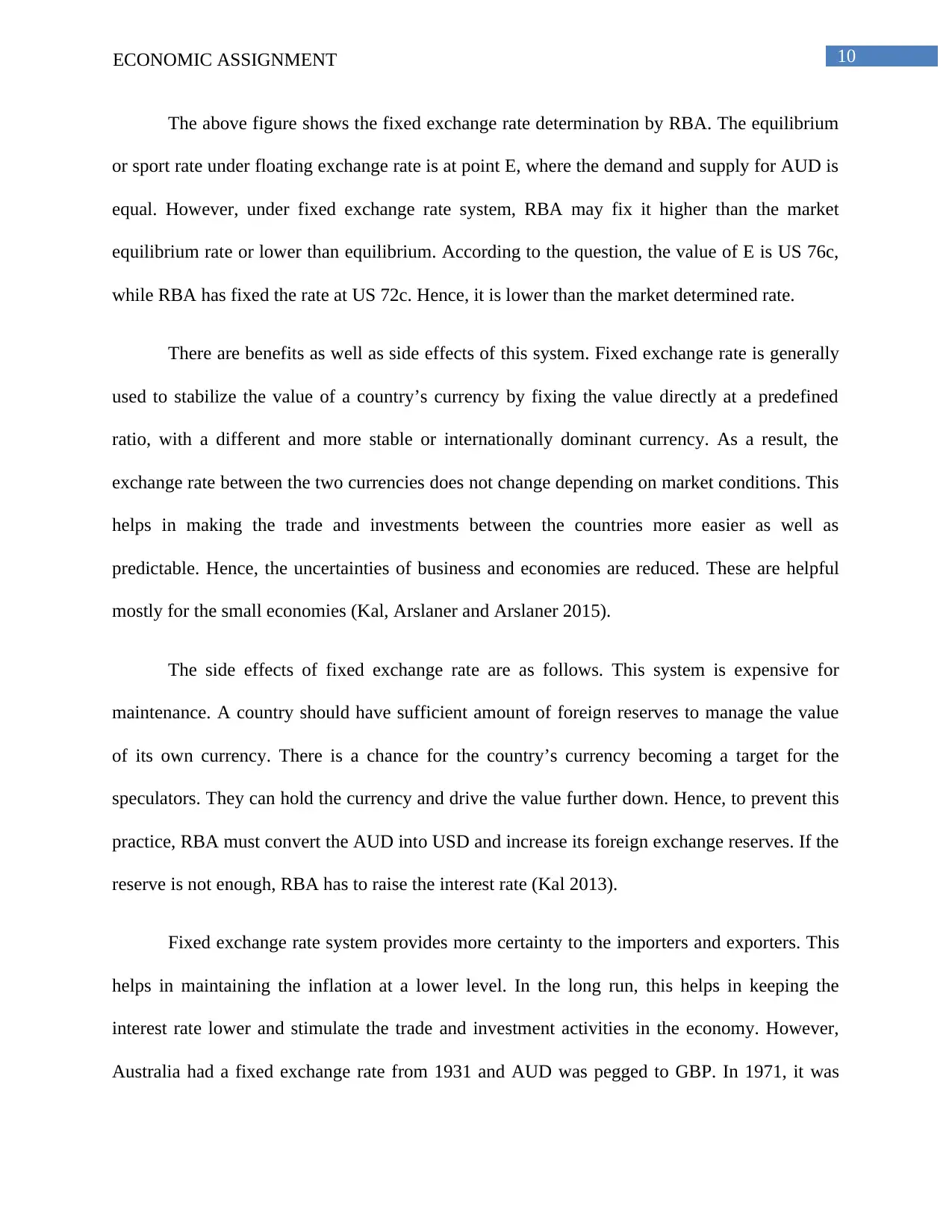
10ECONOMIC ASSIGNMENT
The above figure shows the fixed exchange rate determination by RBA. The equilibrium
or sport rate under floating exchange rate is at point E, where the demand and supply for AUD is
equal. However, under fixed exchange rate system, RBA may fix it higher than the market
equilibrium rate or lower than equilibrium. According to the question, the value of E is US 76c,
while RBA has fixed the rate at US 72c. Hence, it is lower than the market determined rate.
There are benefits as well as side effects of this system. Fixed exchange rate is generally
used to stabilize the value of a country’s currency by fixing the value directly at a predefined
ratio, with a different and more stable or internationally dominant currency. As a result, the
exchange rate between the two currencies does not change depending on market conditions. This
helps in making the trade and investments between the countries more easier as well as
predictable. Hence, the uncertainties of business and economies are reduced. These are helpful
mostly for the small economies (Kal, Arslaner and Arslaner 2015).
The side effects of fixed exchange rate are as follows. This system is expensive for
maintenance. A country should have sufficient amount of foreign reserves to manage the value
of its own currency. There is a chance for the country’s currency becoming a target for the
speculators. They can hold the currency and drive the value further down. Hence, to prevent this
practice, RBA must convert the AUD into USD and increase its foreign exchange reserves. If the
reserve is not enough, RBA has to raise the interest rate (Kal 2013).
Fixed exchange rate system provides more certainty to the importers and exporters. This
helps in maintaining the inflation at a lower level. In the long run, this helps in keeping the
interest rate lower and stimulate the trade and investment activities in the economy. However,
Australia had a fixed exchange rate from 1931 and AUD was pegged to GBP. In 1971, it was
The above figure shows the fixed exchange rate determination by RBA. The equilibrium
or sport rate under floating exchange rate is at point E, where the demand and supply for AUD is
equal. However, under fixed exchange rate system, RBA may fix it higher than the market
equilibrium rate or lower than equilibrium. According to the question, the value of E is US 76c,
while RBA has fixed the rate at US 72c. Hence, it is lower than the market determined rate.
There are benefits as well as side effects of this system. Fixed exchange rate is generally
used to stabilize the value of a country’s currency by fixing the value directly at a predefined
ratio, with a different and more stable or internationally dominant currency. As a result, the
exchange rate between the two currencies does not change depending on market conditions. This
helps in making the trade and investments between the countries more easier as well as
predictable. Hence, the uncertainties of business and economies are reduced. These are helpful
mostly for the small economies (Kal, Arslaner and Arslaner 2015).
The side effects of fixed exchange rate are as follows. This system is expensive for
maintenance. A country should have sufficient amount of foreign reserves to manage the value
of its own currency. There is a chance for the country’s currency becoming a target for the
speculators. They can hold the currency and drive the value further down. Hence, to prevent this
practice, RBA must convert the AUD into USD and increase its foreign exchange reserves. If the
reserve is not enough, RBA has to raise the interest rate (Kal 2013).
Fixed exchange rate system provides more certainty to the importers and exporters. This
helps in maintaining the inflation at a lower level. In the long run, this helps in keeping the
interest rate lower and stimulate the trade and investment activities in the economy. However,
Australia had a fixed exchange rate from 1931 and AUD was pegged to GBP. In 1971, it was
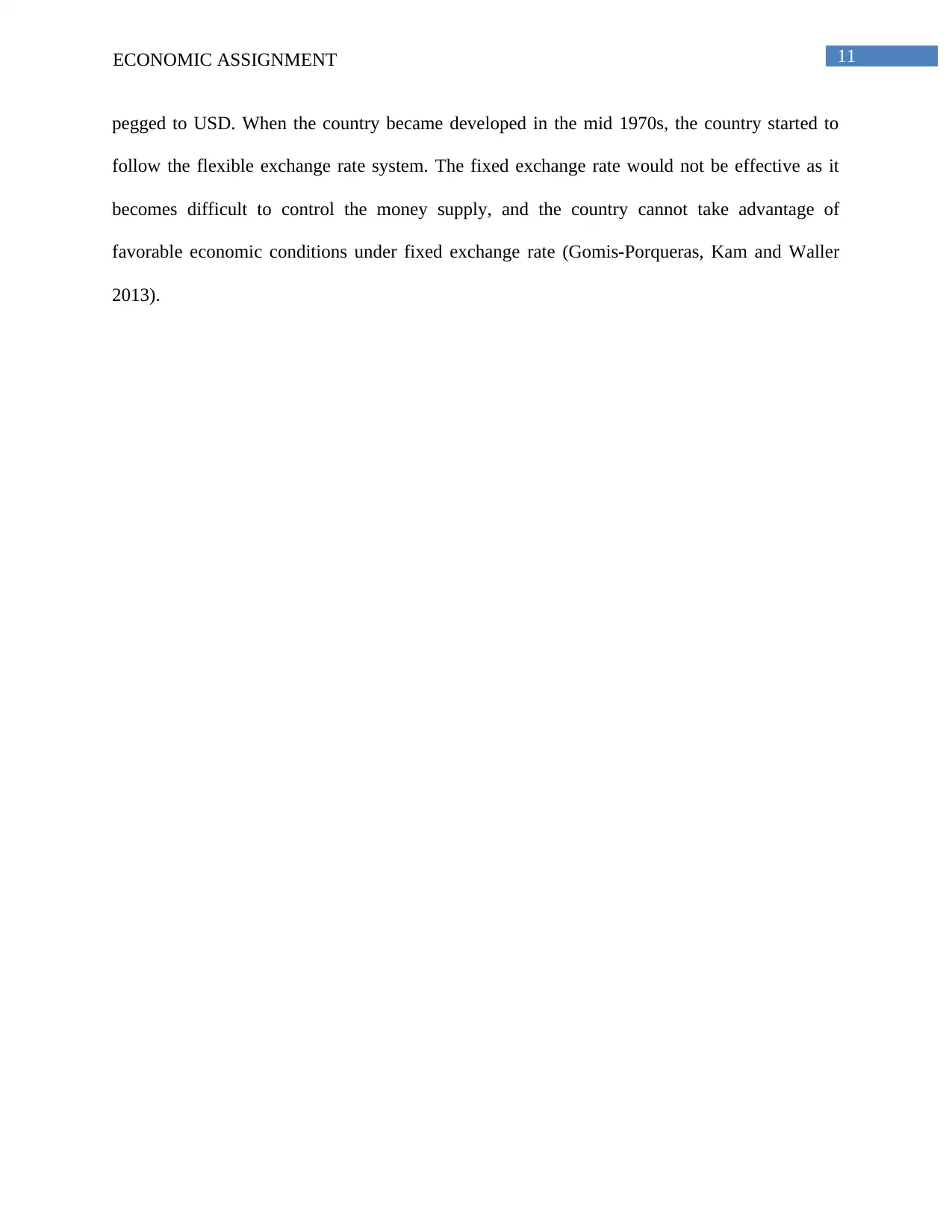
11ECONOMIC ASSIGNMENT
pegged to USD. When the country became developed in the mid 1970s, the country started to
follow the flexible exchange rate system. The fixed exchange rate would not be effective as it
becomes difficult to control the money supply, and the country cannot take advantage of
favorable economic conditions under fixed exchange rate (Gomis-Porqueras, Kam and Waller
2013).
pegged to USD. When the country became developed in the mid 1970s, the country started to
follow the flexible exchange rate system. The fixed exchange rate would not be effective as it
becomes difficult to control the money supply, and the country cannot take advantage of
favorable economic conditions under fixed exchange rate (Gomis-Porqueras, Kam and Waller
2013).
⊘ This is a preview!⊘
Do you want full access?
Subscribe today to unlock all pages.

Trusted by 1+ million students worldwide
1 out of 15
Related Documents
Your All-in-One AI-Powered Toolkit for Academic Success.
+13062052269
info@desklib.com
Available 24*7 on WhatsApp / Email
![[object Object]](/_next/static/media/star-bottom.7253800d.svg)
Unlock your academic potential
Copyright © 2020–2025 A2Z Services. All Rights Reserved. Developed and managed by ZUCOL.





